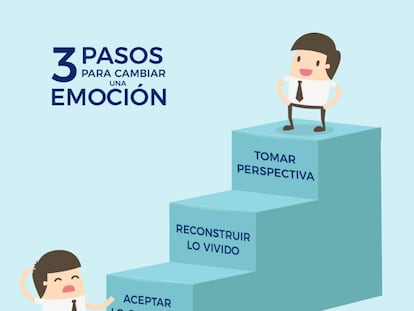The basics of attachment theory: How do you relate to your child?
There are four main categories but they all revolve around two main concepts, protection and autonomy

Attachment, far from being synonymous with dependence as popular culture would have it, reflects a fundamental relationship in our own development and growth. Without attachment, we could not survive. Attachment is a kind of special relationship between children and their parents or main caregivers. Depending on how the latter connect and respond to the children’s needs, a different kind of attachment will emerge.
We could talk about many elements that lead to either a secure or insecure attachment, but let’s focus on just two of them: protection and autonomy. These two variables are like the gas pedal and the brake in a car: they are both equally important. It’s the same with attachment, where it’s just as important to protect the minors when they need it as it is to encourage their self-reliance and empower them to do things by themselves. But be careful about taking these two variables to extremes.
An excess or absence of both protection and autonomy could indicate some kind of insecure attachment, and needless to say, also entails a lot of suffering. As explained by the American-Canadian psychologist Mary Ainsworth, who co-developed attachment theory in the 1960s and 1970s, secure attachment is a flexible balance between protection and autonomy.
The following are some keys to the four types of attachment so that you can identify how you relate with your child:
Secure attachment
Parents and teachers are able to respond adequately to the child’s protection and autonomy needs. They know what their children and students need at every turn. Following the simile of the car pedals, they know that they need to brake on the curves and that they can speed up on the straights. They know how to connect with the child’s needs, and offer a sensitive and proportionate answer to the need expressed by the child. For instance, if the child falls down, the parents will understand that the child is scared and will allow them to cry. The parents will validate that fear and offer protection for as long as it takes. Mothers and fathers with secure attachments avoid relationships based on power and punishment, and instead identify with a democratic style of parenting. They represent 50% to 60% of the world population.
Avoidant-insecure attachment
Parents in this kind of relationship do not respond adequately to their children’s emotional needs. When the children express fear, anger or sadness, these parents typically ignore or minimize those emotions. To them, showing emotion is a sign of weakness. They don’t pay attention to their emotional world, and place too much stress on academic achievement and proper behavior. That’s why I usually say that they are left-brain-hemisphere parents (cold and calculating). When the child expresses fear or sadness, they reply with things like “that’s nothing,” “it’s not so bad” or “don’t exaggerate.” They don’t validate the minor’s emotional experiences. That is why they often end up manifesting their psychological stress through physical symptoms in what is known as somatization. They are excessively scared of intimacy and they “disconnect” from the emotional world. Around 20% of the population falls in the avoidant attachment category, and it is much more frequent in men than in women.
Anxious-ambivalent insecure attachment
We might say that this is pretty much the opposite of avoidant insecure attachment. If the latter is defined by difficulty in establishing relationships of trust with others, in anxious-ambivalent insecure attachment there is an excessive fear of separation and abandonment. The reason this attachment is called anxious-ambivalent is that parents’ responses are variable and changing, which creates a lot of anxiety in the children. They are parents who focus excessively on protection and overlook autonomy and growth. This type of attachment matches the overprotective educational style, which accounts for 15% of the population and is more common in women than in men. These people have a lot of trouble managing their own emotions and connecting with their real needs. And if they can’t manage that, it’s hard to ask them to connect with and meet the needs of their own children or students.
Disorganized insecure attachment
This is the most chaotic type of attachment there is. People in this category provide neither the protection nor the autonomy that their children need. They are parents with a lot of trouble connecting with their own needs, and very likely suffer from conditions such as depression, personality disorders, bipolar disorder, schizophrenia and more. They probably had a traumatic childhood lacking in love and protection. This attachment is called this way because the caregivers make the children feel scared and unprotected. They account for five to 10% of the population.
All parents and teachers have occasionally engaged in all four types of attachment with their children and students. But to know which one is the predominant category, we should be aware of how we routinely relate to our children’s emotional needs. If, faced with their fears, anger or jealousy, we are able to connect with their feelings and respond adequately most of the time, then we are very likely a security figure for our children. If, instead, we typically respond in a rational way without taking emotions into account, we are probably the avoidant type. If we overprotect our children and are guided by fear, we are likely anxious-ambivalent. I hope these guidelines will help you become more aware of how you relate to your children.
Tu suscripción se está usando en otro dispositivo
¿Quieres añadir otro usuario a tu suscripción?
Si continúas leyendo en este dispositivo, no se podrá leer en el otro.
FlechaTu suscripción se está usando en otro dispositivo y solo puedes acceder a EL PAÍS desde un dispositivo a la vez.
Si quieres compartir tu cuenta, cambia tu suscripción a la modalidad Premium, así podrás añadir otro usuario. Cada uno accederá con su propia cuenta de email, lo que os permitirá personalizar vuestra experiencia en EL PAÍS.
¿Tienes una suscripción de empresa? Accede aquí para contratar más cuentas.
En el caso de no saber quién está usando tu cuenta, te recomendamos cambiar tu contraseña aquí.
Si decides continuar compartiendo tu cuenta, este mensaje se mostrará en tu dispositivo y en el de la otra persona que está usando tu cuenta de forma indefinida, afectando a tu experiencia de lectura. Puedes consultar aquí los términos y condiciones de la suscripción digital.
More information
Últimas noticias
Aquilino Gonell, former Capitol sergeant: ‘If it hadn’t been for the police, the US would be a dictatorship’
A hybrid building: Soccer pitch, housing, and a shopping mall
Europe urges Trump to respect Greenland following annexation threats
Science seeks keys to human longevity in the genetic mixing of Brazilian supercentenarians
Most viewed
- Alain Aspect, Nobel laureate in physics: ‘Einstein was so smart that he would have had to recognize quantum entanglement’
- Mexico’s missing people crisis casts a shadow over World Cup venue
- Alvin Hellerstein, a 92-year-old judge appointed by Bill Clinton, to preside over Maduro’s trial in New York
- Why oil has been at the center of Venezuela-US conflicts for decades
- Cuba confirms death of 32 of its citizens in the US attack against Venezuela











































